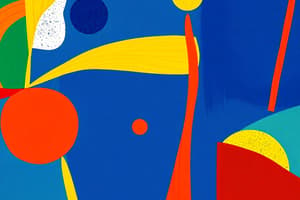Podcast
Questions and Answers
Which design principle focuses on the size relationships within a design, often utilizing concepts like the Golden Section?
Which design principle focuses on the size relationships within a design, often utilizing concepts like the Golden Section?
- Proportion (correct)
- Unity
- Scale
- Balance
When designing a room, considering the height of a doorway in relation to the average human height is an application of which principle?
When designing a room, considering the height of a doorway in relation to the average human height is an application of which principle?
- Emphasis
- Rhythm
- Variety
- Scale (correct)
Creating a design where one half mirrors the other exemplifies which type of balance?
Creating a design where one half mirrors the other exemplifies which type of balance?
- Symmetrical Balance (correct)
- Radial Balance
- Dynamic Balance
- Asymmetrical Balance
In a garden design, repeating a pattern of flowering plants along a pathway to guide the viewer's eye demonstrates which principle of design?
In a garden design, repeating a pattern of flowering plants along a pathway to guide the viewer's eye demonstrates which principle of design?
What is the primary purpose of emphasis in a design?
What is the primary purpose of emphasis in a design?
Which design principle involves creating a sense that all elements in a design belong together and share a common theme?
Which design principle involves creating a sense that all elements in a design belong together and share a common theme?
Combining different styles, materials, or colors in a design to prevent monotony and add interest is the application of which principle?
Combining different styles, materials, or colors in a design to prevent monotony and add interest is the application of which principle?
Why is understanding the principles of design important in the creation of visual works?
Why is understanding the principles of design important in the creation of visual works?
Which of the following examples best demonstrates the principle of 'gradation' in rhythm?
Which of the following examples best demonstrates the principle of 'gradation' in rhythm?
In asymmetrical balance, how is equilibrium achieved?
In asymmetrical balance, how is equilibrium achieved?
What is the primary characteristic of a 'focal point' created through emphasis?
What is the primary characteristic of a 'focal point' created through emphasis?
How does variety contribute to the overall impact of a design?
How does variety contribute to the overall impact of a design?
If a room is designed with furniture and décor that all share a similar color palette and style, which principle of design is being emphasized?
If a room is designed with furniture and décor that all share a similar color palette and style, which principle of design is being emphasized?
Which type of rhythm is achieved by arranging elements so that they radiate outward from a central point?
Which type of rhythm is achieved by arranging elements so that they radiate outward from a central point?
How does scale affect the perception of space in interior design?
How does scale affect the perception of space in interior design?
What is the role of 'opposition' as a type of rhythm in design?
What is the role of 'opposition' as a type of rhythm in design?
Which principle is most concerned with the visual weight and arrangement of elements to create stability?
Which principle is most concerned with the visual weight and arrangement of elements to create stability?
What distinguishes design that incorporates unity from one that lacks it?
What distinguishes design that incorporates unity from one that lacks it?
What is the purpose of transition as a type of rhythm in design?
What is the purpose of transition as a type of rhythm in design?
Which of the following design scenarios would require careful consideration of 'proportion'?
Which of the following design scenarios would require careful consideration of 'proportion'?
Flashcards
Proportion
Proportion
Refers to the size relationships within an object or design.
Scale
Scale
How an object's size relates to human beings or other objects in a design
Balance
Balance
The design principle providing a feeling of equality.
Rhythm
Rhythm
Signup and view all the flashcards
Emphasis
Emphasis
Signup and view all the flashcards
Unity
Unity
Signup and view all the flashcards
Variety
Variety
Signup and view all the flashcards
Study Notes
- Chapter 19 focuses on Principles of Design
- Understands how to implement the elements of design by recognizing the seven basic principles
The 7 Principles of Design
- Proportion
- Scale
- Balance
- Rhythm (Repetition)
- Emphasis (Focal Point)
- Unity
- Variety
Proportion
- Refers to the size relationships within an object or design.
- Includes the Golden Section, the Golden Rectangle, and recognizing good proportion
Scale
- Refers to how the size of an object or space relates to human beings and other objects or spaces in a design.
- Includes the Human Scale
Balance
- It provides a feeling of equality
- Symmetrical balance
- Asymmetrical balance
Rhythm
- Suggests connected movement between different parts of a design
- Repetition
- Radiation
- Gradation
- Opposition
- Transition
Emphasis
- "Center of interest"
- "Focal point"
Unity and Variety
- Unity occurs when all parts of a design are related by one idea
- Variety occurs when different styles and materials are combined
Studying That Suits You
Use AI to generate personalized quizzes and flashcards to suit your learning preferences.




